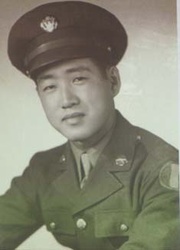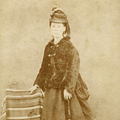Rob Sato communicates through his paintings
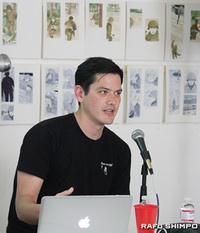
Rob Sato, a Japanese-American artist, painted the 442nd Regimental Combat Team, a Japanese-American unit deployed to the European front during World War II, and the lives of people in internment camps. Sato's grandfather pledged loyalty to the United States during the war, answering "YES" to the loyalty registration question. Meanwhile, Diana Emiko Tsuchida, who is researching Japanese-American history, had a grandfather who answered "NO." We spoke to the two men, whose grandfathers were polar opposites, about their thoughts and family stories.
"YES--" Grandfather pledged allegiance to the United States
Sato is a Los Angeles-based artist whose watercolors were used as illustrations for the graphic novel "442," written by Koji Steven Sakai and Finney Kiyomura, about the 442nd Regimental Combat Team, and were recently exhibited at the Giant Robot 2 Gallery in West Los Angeles.
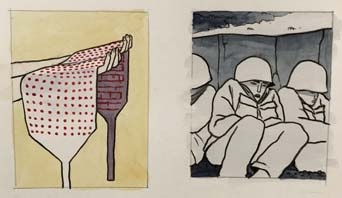
In 1943, Japanese Americans who were sent to internment camps as "enemy aliens" were asked by the U.S. government at the time questions such as "Would you like to volunteer for the U.S. military?" and "Would you renounce your loyalty to the United States and the Emperor of Japan?" One person who answered "YES, YES" to these two questions was Sato's grandfather, Roy (93).
During the war, Roy was interned in Jerome, Arkansas, and then in Rohwer, Arkansas, and served in the 442nd Regimental Combat Team in Europe.
Many second-generation Japanese-Americans volunteered or were drafted into the 442nd Combat Team after being incarcerated in internment camps, and were sent to the battlefield. They performed harsh duties on the battlefield, and their fierce fighting is illustrated by the death and injury rate of 314% and the number of deaths and injuries of 9,486. As one of the most decorated military units in the history of the United States, the unit is praised by the public as a hero.
"My grandfather served in the 442nd Regimental Combat Team during the war, but for a long time he refused to talk about his experiences in the war. But in the 1980s, as we grandchildren grew older, he began giving presentations about life in the concentration camps and the war at community events and in schools."
The second generation of Japanese who experienced World War II are getting older, and opportunities to hear their stories directly are disappearing. When the proposal to illustrate the novel came up, Sato felt he had to use his grandfather's experiences and his own background. "It was a very valuable experience to hear my grandfather's stories directly while illustrating the 442nd Regimental Combat Team."
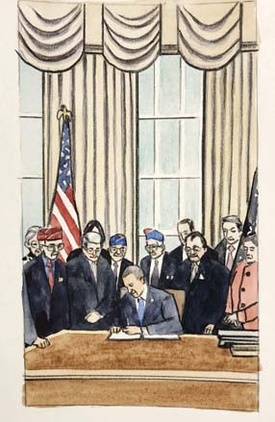
Sato's watercolors depict in detail the expressions of the Japanese-American soldiers of the 442nd Regimental Combat Team, as well as the "sennin-bari" (a thousand-needle charm) that women sent to their sons or husbands going off to war, the riots that occurred at the internment camps, and then-President Obama signing a bill in 2010 to award the 442nd Regimental Combat Team the Congressional Gold Medal.
Grandpa Roy remained proud of being an American and of fighting for his country, even when his family was imprisoned in internment camps by the U.S. government at the time.
I wonder how Sato feels about people like Tsuchida's grandfather who answered "no" to the loyalty registration question and made a decision that was the polar opposite of his own grandfather's.
"I also have a lot of respect for Tsuchida's grandfather's decision (to not pledge allegiance). I think that whether he answered 'YES' or 'NO', both made the right decision in the end. Japanese Americans at that time could not escape the loyalty registration question. It was the situation at the time (the anti-Japanese movement) that was wrong. Japanese American history is a part of American history. I would be happy if people who have not known about the history of Japanese Americans until now could learn about it through this opportunity," Sato said.

*This article is reprinted from The Rafu Shimpo (May 8, 2018).
© 2018 Junko Yoshida / Rafu Shimpo



